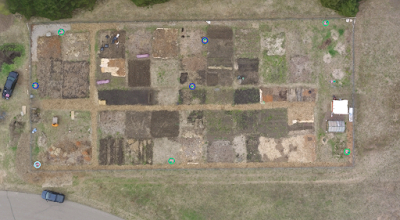This week the students drove down to some wetlands in Tomah,Wisconsin. Here is where we met up with Peter Menet and the Trimble UX5. Very similar to last weeks lab we had set up the GCP's in the wetlands over a large area. Using the total station, accurate GPS coordinates were taken wherever a GCP was placed.
The first thing that was assembled for the fixed wing UX5 was the rail catapult launch system which extended to roughly 6 to 7 meters. The launch system had a crank and bungee that were used to allow the UX5 to be slung into the air before the motor took over.
Figure 1. UX5 setup and installation.
Following the setup of the launcher, preflight checklist and mission planning for the UX5 were put in place. The cool part about the UX5 and its software system that is already installed is that before you even fly, the program on the controller makes you go through a preflight checklist. Then you input certain parameters for the area you are flying and what type of conditions that you are in. The unfortunate part about this software is that there are no manual controls in case of an emergency you cannot just take over. After about a half an hour to forty minutes of preflight checking and mission planning the UX5 was ready for take-off. The launch was as easy as pressing a clamp and letting the program takeover once its in the air. The UX5 flew at roughly 55 mph and an altitude of 400 feet. When the mission was done for the UX5, it came in for the automatic landing and was extremely rough, but it lives to die another day.
Figure 2. UX5 launcher setup.
The next flight was with the M600 which was a multi-rotor with 6 propellers and had much larger dimensions. After the preflight checklist and the M600 was put together, and a mission plan was put together.
Figure 3. M600 being setup up.
Figure 4. M600 in midflight with the landing gear up.











